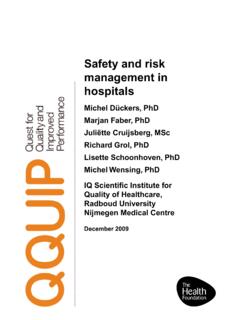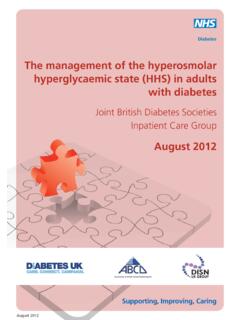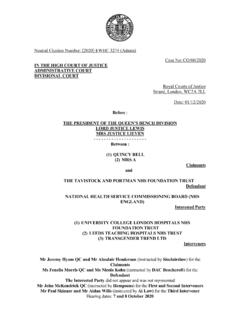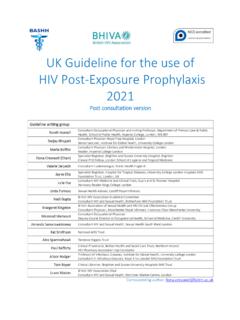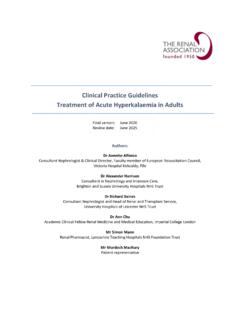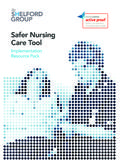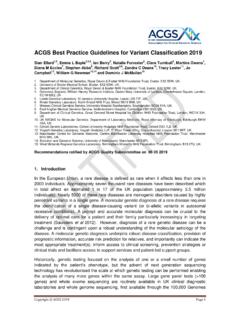Transcription of Continuous improvement of patient safety - Health …
1 Learning report November 2015. Continuous improvement of patient safety The case for change in the NHS. John Illingworth Acknowledgements A number of people contributed to the development of this report and we are very grateful for their help. We would like to thank Carl Macrae, Jane Carthey, Mary Dixon-Woods, Charles Vincent and Don Berwick for their input, along with all those who contributed viewpoints. We would also like to thank Angelina Taylor and other Health Foundation colleagues for their contribution and advice. Continuous improvement of patient safety is published by the Health Foundation, 90 Long Acre, London WC2E 9RA. ISBN: 978-1-906461-70-6. 2015 The Health Foundation Contents Foreword 2. Executive summary 4. Health Foundation patient safety projects in 2015 6. Introduction 8. Part I: The case for change 9.
2 Learning from major safety failings 9. Why is it so difficult to improve safety ? 10. The state of patient safety in the NHS 12. Part II: safety improvement in practice 16. Measurement and monitoring 16. improvement and learning 18. Engagement and support 21. Strategy and accountability 25. Supporting safety improvement in practice 28. Part III: Making the system safer 30. Perspectives from the NHS 30. Thinking differently about patient safety 31. Our vision for an effective safety system 33. References 36. Contents 1. Foreword The pursuit of safety is not for the timid. This Health Foundation report eloquently surveys the landscape of obstacles. But there are at least two inescapable facts that make improving safety especially difficult and frustrating. First, securing safety is a task that cannot be finished', ever.
3 As Professor James Reason puts it: safety is a continually emerging property of a complex system.' The threats to safety flow like an endless game on a football field, in which no two patterns and no two moments are ever the same. Linear thinking the search for simple, single causes is doomed. All modern approaches to achieving safety (or reliability, for that matter) require continual attention to adjustments, resilience, adaptation and local contexts. It is so tempting, especially in politicised contexts, to try for simple answers, to plug in'. safety like one plugs in a toaster. Certainly, there are techniques that can help. Checklists, monitoring devices, transparent metrics, standardised processes these and many other mechanics have proven their worth in the right context at the right time. But, fundamentally, the quest for the installable fix' is doomed.
4 The most important cultural characteristic of the safest enterprises is not that they have the right technical features in place (although they should), but rather that they are full of people at all levels who can sense, change, adapt and change again in response to the ever-changing terrain of threat and challenge and are supported by their leaders to do so. Indeed, in that sense, safer systems are safer because they are never the same twice. That's what James Reason means by a continually emerging property'. Second, the pursuit of safety depends on volunteerism. It is more about what people choose to do than about what they are required to do. safety cannot, in any meaningful sense, be required of a workforce or, for that matter, of those they serve. For leaders, this means that their job is continually to try to build on and support intrinsic motivation.
5 For understandable reasons, the temptation to depend on rules and requirements is seductive. For one thing, it's a lot easier. For another, organisations and societies obviously do need rules. We don't want roads without speed limits, electrical plugs without grounding, or mains water with harmful germs. But Ren Amalberti et al emphasise the importance of distinguishing between (and acting differently on) extreme violations'. (which are rare and intolerable) and borderline tolerated conditions of use' (which are pervasive, inevitable, and often wise and informative violations of rules).1. Similarly, Karl Weick has clearly elucidated the properties of very safe, high reliability organisations' (HROs), and strongly emphasises the crucial capacity of sensemaking' in achieving their Understanding and honouring these behavioural and cultural elements of what I might call deep' safety as opposed to compliant' safety or looking good' safety demands a level of maturity and psychological sophistication that are too often simply not in the repertoire of an organisation, a leadership system, or a political economy.
6 2 Continuous improvement of patient safety It is for this reason that the National Advisory Group on the safety of patients in England,3. which it was my honour to chair, determined that culture will trump rules. That is not a soft idea; it is one grounded in evidence and safety science. This report from the Health Foundation could be a landmark. Carefully studied and thoroughly acted on, it could mark a shift in the maturity of the safety movement, at least in the UK. It could signal a change from a movement that has been, with all good intention, too tethered to rules and requirements as the anchors for patient safety , to one far better informed by the scientific insights of Amalberti, Reason, Weick, Vincent and others who have been trying to teach us to eschew simple mechanics and embrace the pursuit of safety in all its subtle but nonetheless powerful human dimensions.
7 Above all else, the key lesson seems to be this: seeking safety raises the question How do we want to be?' far more emphatically than the question What do we want to require?'. A rule-bound organisation cannot be truly safe. That requires things more important than rules: things like maturity, curiosity, dialogue, daylight, reflection, teamwork, hope and trust . It's a tougher job for leaders than simply writing and enforcing rules. The difference is, it works. Donald M. Berwick, MD. President Emeritus and Senior Fellow, Institute for Healthcare improvement Foreword 3. Executive summary This report makes the case for changing the way patient safety is approached in the NHS. It argues that change is needed in: how safety is understood, because current approaches to measurement don't provide the full picture; how safety is improved, because existing approaches alone will not address the most intractable problems; how risk is perceived, because comfort-seeking behaviours will not create a genuine culture of learning.
8 The patient safety movement is now at a critical moment; to sustain momentum, there has to be recognition that things can and should be better. There have been some remarkable successes in recent years to improve patient safety and tackle harm, and front-line teams supported by the Health Foundation have been an important part of these efforts (see pages 6-7 for examples of some of our current work). This report brings together what we have learned from this work, and also highlights some salutary lessons about the state of patient safety in the NHS and the complex task of continually trying to improve it. We have learned that many systems are not designed with safety in mind, meaning that it is only the skill and resilience of Health care professionals that prevents many more episodes of harm. We have learned that many care processes are unreliable, which can mean that the right equipment isn't available in theatre, or the wrong drug is given to a patient .
9 We have learned that many institutions don't have a complete picture of safety , because they focus largely on past events rather than current or future risks. We have learned that there are some common factors that have repeatedly contributed to large-scale failings, but that these factors have consistently not been addressed. Despite the many successful quality improvement projects the Health Foundation has supported, there have been many more that haven't delivered the expected benefits. We are only now coming to fully understand the reasons for this. For instance, front-line teams consistently come up against big and hairy' issues such as inadequate information technology, inconsistent staffing and challenging established cultures. Yet these issues are far beyond the scope of individual teams, and the scope of quality improvement methods alone, to address.
10 If the most intractable safety problems require nationally coordinated solutions, then existing approaches will not yield the future gains that patients and the public expect. So what might safer care look like in the future? In our view, a safer care system is conceived from the perspective of the patient , following his or her journey through different care settings, irrespective of organisational boundaries. It is networked, so that successes and failures identified in one part of the system can be readily accessed, understood and built on in another. And it is judged not by the prevalence of adverse events, but by the ability to proactively identify hazards and risks before they harm patients . 4 Continuous improvement of patient safety How can we get there? The journey must begin with practical improvements, based on what is known to work.



